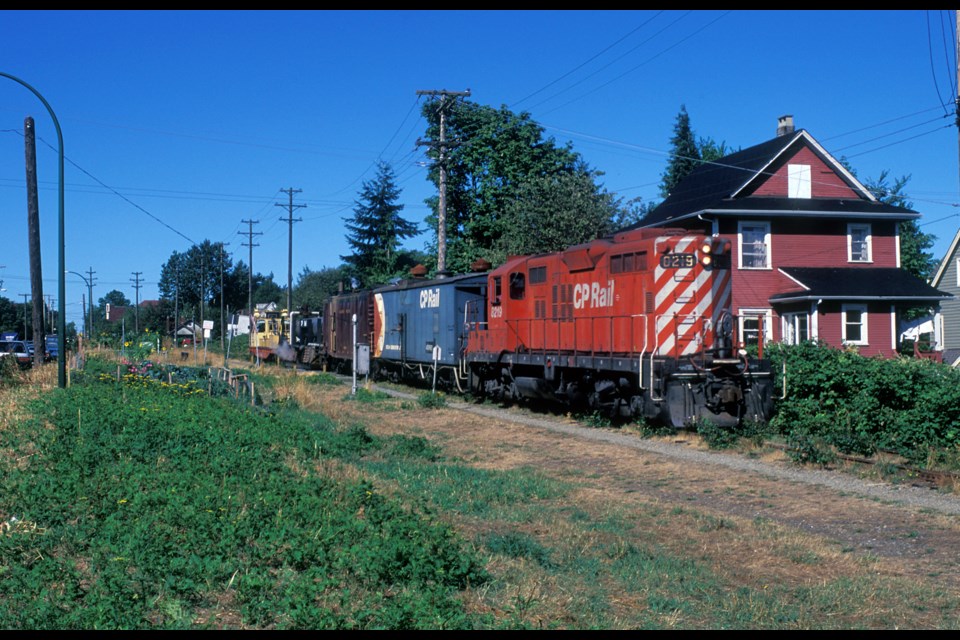Bramble bushes with stems the size of a child’s wrist strangle the old railway tracks underneath the south side of the Burrard Street bridge now, but up until 1982 they met the Kitsilano trestle over which the B.C. Electric Railway once trundled.
The trestle was torn down just four years shy of its 100th birthday and while the slip of land where the tracks lead out is overgrown and unremarkable, evidence of Vancouver’s railway history pokes out here and there on the gravel access road under the bridge.
It’s a good place to start a walk along the Arbutus rail line heading north to south.
The line crosses West First Avenue with the long-silent crossing signals — markers perhaps purposefully kept by Canadian Pacific Railway as a reminder of who really owns this corridor of land.
The scenery changes from one side of the road to the other; wild growth and somebody’s camp gives way to orderly gardening with a sign warning not to steal anything or risk making Esme, a young gardener, upset.
The tracks cut across West Fourth and the trimmed grass between metal and wood is the only greenery, otherwise the space is a backyard for car lots and garbage bins. Across the tracks at the entrance to the lush garden at Fir Avenue sits a beat-up Chevy cargo van, a bookend between industry and persistent nature.
The garden at West Sixth has reached park proportions with a subdivision of planter boxes with edibles, flowers and apple trees. Weeds stuffed into gardening bags lean against CPR’s faded and rusty No Trespassing sign, cheerfully ignored like children no longer avoiding the neighbourhood crank’s house because he’s moved into a care home.
The track cuts over West Seventh and up Arbutus Street for the longest straightaway of the Arbutus Corridor line’s journey. The ragged stretch of track between West Broadway and West 12th is known as a “party zone” according to a woman who sniffed her disapproval during her walk to work. A few steps down the line, to prove her point, a couple of guys were cracking open beer and sitting on a concrete box.
Oddly out of place are the rail crossing signs at West 14th. The posts have a new coat of paint and the X is sparkly clean, interesting considering the last time engine 1237 dropped off its malt and barley at the Molson Brewery was May 2001.
Abe Van Oeveren, who tends to his trackside garden nearby the crossing, is a bit of a train buff. He’s lived in the neighbourhood since 1984 and remembers how Dave the engineer used to wave, sometimes blowing his horn, when they saw one another.
“I miss the trains,” he said. “I used to have to straighten all the pictures in the house after it would rumble by.”
Down the slight valley and up the tracks turn near Quilchena Park where a view of the ocean is seen over the tops of the houses. The tracks have plenty of cow-catching room at West 42nd so the extra space seems to lend itself to a feeling of more permanency for gardens as sheds have been built complete with cottage fencing, not to mention a scarecrow dressed as a cyclist.
The closeness of the Vancouver International Airport is evident by low-flying aircraft near West 60th Avenue. Just past Rand Avenue there’s a typed plea by the exasperated-sounding Wits End Co-op not to build a garden near the tracks because an endangered bird species likes to hide in the underbrush.
A few metres down the way, young Ben and brothers Lars and Rainier hung out with their “attack” tabby cat named Barney in their hang-out they carved out of the bushes, complete with a couple of abandoned office chairs. The cat ran off, and Rainer, while playing the guitar, mentioned there was a secret tunnel nearby but it meant crawling through blackberry bushes to find it. The boys didn’t seem to care much for the idea of their hideout being ruined by a train.
“The train would probably take out all the gardens, too,” said Lars. “That’s bull!”
The temperature felt about 10 degrees warmer by Southwest Marine Drive’s rush hour. Here the tracks pass by warehouse, car lots, and concrete piping makers. Yet in the middle of all the noise and industry of the riverside there was a small garden with a bathtub of flowers.
The Arbutus line, and the five-hour walk, ended with a padlock at two gate doors leading to a swing bridge over the river to Richmond.
Tracking the Arbutus line’s history
- The Arbutus Corridor line was built in 1902 after the province granted the land to Canadian Pacific.
- The Kitsilano Trestle, which spanned False Creek near where the current Burrard Street Bridge is today, was built by Canadian Pacific in 1886 and torn down in 1982. It was said to be a navigational hazard for passing boats.
- The last passenger train ran along the Arbutus Corridor in 1954 and the last freight train in 2001.
- Canadian Pacific’s only customer on the Arbutus line was Molson Brewery when it stopped running.
- The Arbutus Corridor line starts near Granville Island and passes through Kitsilano, Arbutus Ridge/Shaughnessy, Kerrisdale and Marpole before crossing a swing bridge into Richmond.
- The Arbutus Corridor sits on combined land roughly the size of 45-acres.
- After pubic hearings in 2000, the city passed the Arbutus Corridor Official Development Plan that designated the land for transportation, parks, and/or greenways even though the land is private property. The CPR took the city to court saying that the city had taken its property for which compensation was due.
- Suggestions were made the city should buy the land or make a deal with CPR but formal discussions faded during years of contentious court battles.



